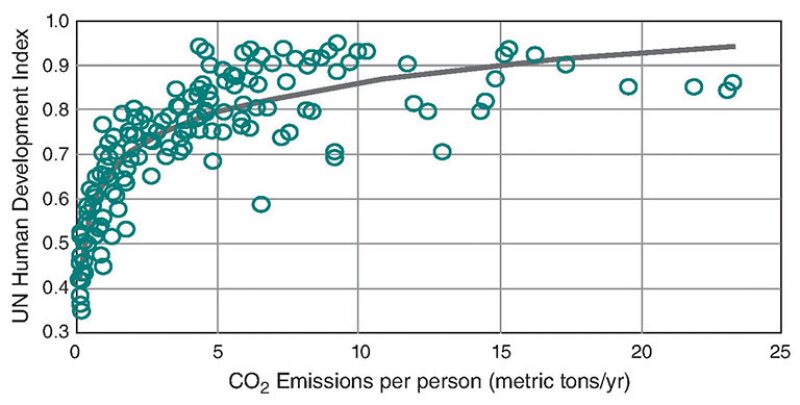
When worldwide oil and gas consumption reached record levels yet again in 2017, SPE members were there when it counted, helping to generate more light and power for billions of people across the world.
The United Nations Human Development Index (HDI), which serves as a proxy for quality of life, shows that populations that consume more fossil fuels are better educated, wealthier, and live longer (Fig. 1). The greatest incremental benefit comes to those who are lifted out of poverty by their first access to cheap energy.

Have we forgotten what life was like without fossil fuels?
For more than five generations, the oil and gas industry has helped raise living standards; protected environments by replacing firewood with natural gas and propane; and provided food to hungry people by increasing farming productivity, transportation, refrigeration, and packaging. Before hydrocarbons, the great whales were almost hunted to extinction to provide oil for lamps. Before the use of hydrocarbons, Europe had cut down almost all of its trees to provide heat. Author Michael Crichton postulated that, before internal combustion engines were common, one of the greatest environmental challenges of the future would have been finding a way to dispose of mountains of horse manure. Life before hydrocarbons was much harder, and the HDI curve shows that, for those who have no access to hydrocarbons, life is still very challenging indeed.
Without the products provided by the industry (shelter, transportation, clothing, heating, and cooling), populations were vulnerable not only to extreme weather events, but also to the effects of everyday weather. With this strong record of benefitting mankind, it would seem natural that those in the industry could rest on their accomplishments. But notice the shape of the curve as the development index approaches 1 and incremental consumption does not necessarily improve human flourishing. Have wealthy populations reached the point of diminishing returns, forgetting what life was like without fossil fuels?
In 2018, the residents of Colorado voted on a new regulation proposed by environmental activists that, ostensibly in the name of safety, would have pushed the oil and gas industry out of the state by cutting off access to future drilling locations. Before the vote, I decided to walk the streets of my neighborhood to make the case for fossil fuels, asking each neighbor how he or she felt about effectively banning the oil and gas industry. Some, I quickly realized, were motivated by fear and beliefs not rooted in reality. To them, this sinister new trend known as “fracking” was responsible for sinkholes, pipeline leaks, all earthquakes, and inclement weather. While each person with whom I spoke was polite and talked with me until I had worn out my welcome, this vocal minority seemed uninterested in information that might challenge their beliefs.
The proposition was defeated, 58–42%, but the industry had to outspend the activists 30 to 1 to defend itself. One of the ironies of the vote was that those who lived near wells, and who would theoretically benefit from additional “safety” measures, voted against the new regulations (75–25%), while those in urban areas voted (30–70%) for greater restrictions on development that would consequently happen somewhere else. If the regulations made people living near wells safer, why wouldn’t they vote for these measures? And why would those who live far from development vote for new regulations that would restrict their access to cheap energy?
Can the HDI plot explain these counterintuitive results? Those who voted against the new regulations are primarily rural. They may benefit directly through a job in the industry or support industries; they may be farmers or royalty owners who receive income from producers. They know what our industry does and see how it improves their lives each day. The other group consists chiefly of urban professionals, working in financial services, software, or government. Some urbanites may not even own cars because fleets of vehicles can deliver all they need to their front doors, one item at a time. Those high on the HDI scale may be willing to pay additional costs for an unquantifiable climate benefit in the distant future, but are they demanding that their less-fortunate neighbors make an even greater proportional sacrifice?
The yellow-vest protests in France began when increased fuel taxes designed to meet climate-change targets were supported in urban areas, but were resisted by those who felt the costs immediately, and who knew benefits would never be measurable. France outlawed hydraulic fracturing in 2011. The US subsidiary of the largest French bank pledged to “no longer do business with companies whose main activity is exploring, producing, distributing, marketing, or trading oil and gas from shale,” while Schlumberger, with the second-largest pressure-pumping fleet on the planet, also is based in France.
The ironies do not end in France, however. Because of abundant hydropower not available elsewhere, Norway considers itself a very green country. Yet Norwegians also produce huge amounts of fossil fuel for others and are one of the few countries that still hunt whales. In 2016, Norway’s Minister of Climate and the Environment acknowledged that Norwegians “have been living well from oil and gas. But there is no country in the world that has done more to undermine the oil and gas industry than Norway.” When this irony was pointed out, he replied, “We know there is a paradox.”
Even though the first multifractured horizontal well was drilled in the North Sea in 1987, the only recent well to be hydraulically fractured onshore in the UK experienced multiple shutdowns during stimulation operations as sensitive instruments measured tremors above the legal limit of 0.5 on the Richter scale. Because that scale is logarithmic, a 0.5 reading is roughly 1,000 times less than the 3 reading at which humans actually can feel movement. What defines a “safe” tremor is a moving target, because vibrations of 0.5 are merely background noise in seismically active places such as Los Angeles, Tokyo, and Jakarta.
The Fossil Fuel Free Challenge
Fossil fuel alternatives—portrayed as clean, free, and powerful—never seem to live up to the advertising. After a tsunami caused the Fukushima Daiichi nuclear disaster, for instance, Germany announced it would close all its zero-emission nuclear plants by 2022, even though only one of 17 active plants was near an ocean. The power generated by idled nuclear plants has been replaced by lignite coal-fired generation, increasing carbon emissions for the foreseeable future. Thousands of mirrors that focus solar power at large-scale concentrated solar facilities also produce showers of flaming birds after they unwittingly fly into the path of these powerful new clean energy sources.
The US Fish and Wildlife Service estimates that wind turbines will cause 1.4 million avian deaths per year by 2030, when wind will supply 20% of US electricity needs. And even in the realm of the individual, complexities exist; it was only after I installed a solar hot water system that I realized the cost to run the two electric circulating pumps was more than the cost of gas to heat an equivalent amount of hot water.
Is the public blind to such “paradoxes”? The message behind the goal of “saving” the planet is so powerful, so compelling, that reason and critical thinking are often discarded in pursuit of the elusive Utopian future. Can’t we in the industry work to build a more comprehensive awareness, perhaps even describe an Atlas Shrugged scenario of what life would be like without fossil fuels? We could, but unfortunately, such measures rarely work. The Fossil Fuel Free Challenge, for instance, was perceived as unwelcome self-promotion.
In 1980, when coal mines were being shut down across Colorado, I saw bumper stickers in affected towns reading, “Ban Mining, Let the (expletive)s Freeze in the Dark.” At the time, I did not understand the frustration expressed by those stickers, because I did not realize that the electricity I used (and still use) was primarily generated with coal. My life did not need coal, so I would be fine if it went away. We take for granted that which we do not have to worry about.
New, diverse (energy) sources will preserve fossil fuels for future use
Working in a car parts factory in 1978 and considering a career in oil and gas, I seriously wondered if oil shale (where one digs up shale, then cooks it to release oil) could keep the oil industry alive after the experts estimated we would run out of regular oil—in 1985. The death of the fossil fuel industry has been prematurely reported for at least 50 years, and the cycle repeats itself as soon as our collective memory forgets the last cycle. The fossil fuel era began around 1920, and the shifting Hubbert’s Peak oil curve currently predicts it may last another century. Renewables are improving and now make up 11% of consumption in the US. That is a good thing, because new, diverse sources will preserve fossil fuels for future use, and petroleum engineers joining the industry in 2050 will benefit from healthy competition.
The industry that changed the world
How do we, SPE members and industry professionals, maintain our motivation when many have forgotten what life was like before our industry changed the world? We do so for the same reason we care about family members who might give us a heartfelt hug immediately before asking for a ride to attend an anti-fossil fuel rally. We should listen to and be respectful of those on the extreme, but not allow ourselves to be bullied.
We can take solace in the knowledge that there is a large silent majority that supports us but may not always show it. We have helped set the stage for the flourishing of the human race for 100 years, and we have raised worldwide living standards more than any industry in the history of mankind. If you want to meet people who truly appreciate the energy that we supply, I suggest visiting a village in the developing world where electricity has recently arrived, where it is considered magical and represents the start of a better, more promising life. Stand tall, and be proud of what we have accomplished.
Original Article: SPE's Journal of Petroleum Technology
.jpg?width=2097&height=770&name=ALP%20logo%20%26%20strapline%20-%20RGB%20(US%20version).jpg)
